Twin bridges
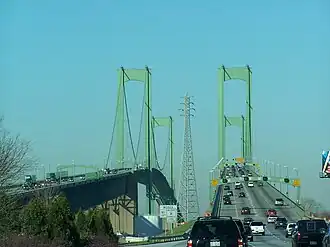
Twin bridges are a set of two bridges running parallel to each other. A pair of twin bridges is often referred to collectively as a twin-span or dual-span bridge. Twin bridges are independent structures and each bridge has its own superstructure, substructure, and foundation.[1] Bridges of this type are often created by building a new bridge parallel to an existing one in order to increase the traffic capacity of the crossing.
Twin-span bridges may or may not have been constructed at the same time, and may not be identical or even the same type of bridge. Many but not all twin bridges carry one-way pairs of traffic.
For a bridge owner, twin bridges can improve the maintenance and management of the structures. For motorists, twin bridges can limit the risk that both directions of traffic will be disrupted by an accident.[1]
List
| Bridge | First span | Second span | Notes | |
|---|---|---|---|---|
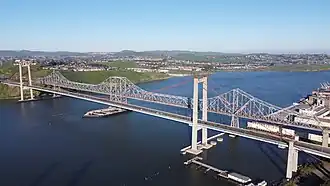
|
Carquinez Bridge | 1958 cantilever span | 2003 suspension span | 2003 span replaced a 1927 cantilever span |
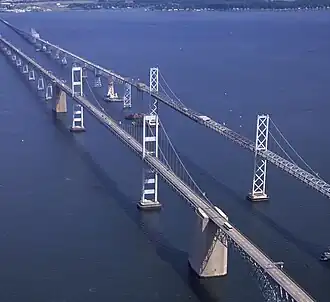
|
Chesapeake Bay Bridge | 1952 suspension and cantilever spans | 1973 suspension and cantilever spans | |
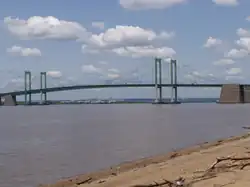
|
Delaware Memorial Bridge | 1951 suspension span | 1968 suspension span | |
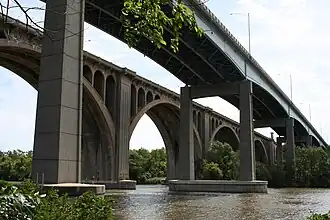
|
Donald and Morris Goodkind Bridges | 1929 Art Deco arch span | 1976 steel bridge | |
| Crescent City Connection | 1958 cantilever span | 1988 cantilever span | ||
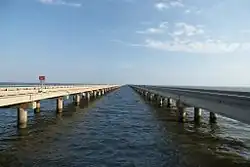
|
Lake Pontchartrain Causeway | 1956 causeway | 1969 causeway | |

|
Bi-State Vietnam Gold Star Bridges | 1932 cantilever span | 1965 cantilever span | |
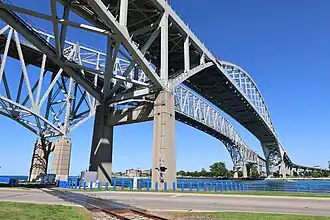
|
Blue Water Bridge | 1938 cantilever span | 1997 tied arch span | |
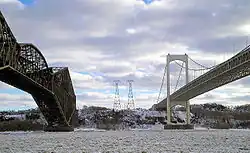
|
Québec Bridge and Pierre Laporte Bridge | 1919 cantilever span | 1970 suspension span | Not a one-way pair |
.jpeg)
|
Tacoma Narrows Bridge | 1950 suspension span | 2007 suspension span | 1950 span replaced a collapsed 1940 span |
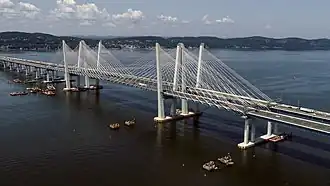
|
Tappan Zee Bridge | 2017 cable-stayed spans | ||
| Newburgh–Beacon Bridge | 1963 continuous truss span | 1980 continuous truss span | ||
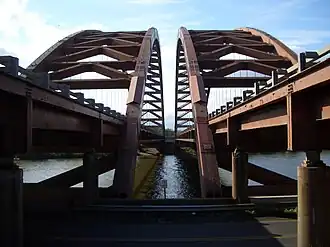
|
Thaddeus Kosciusko Bridge | 1961 through-arch spans | ||
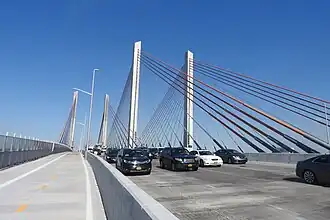
|
Kosciuszko Bridge | 2017 cable-stayed span | 2019 cable-stayed span | |
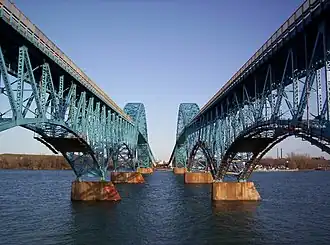
|
South Grand Island Bridge | 1935 truss-arch span | 1962 truss-arch span | |

|
John F. Kennedy Memorial Bridge and Abraham Lincoln Bridge | 1963 cantilever span | 2015 cable-stayed span | |
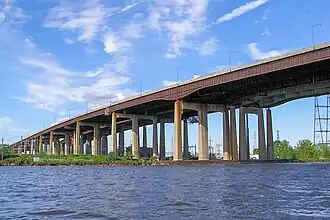
|
Chaplain Washington and Harry Laderman Bridges | 1952 causeway | 1970 causeway | Not a one-way pair; each bridge carries bidirectional traffic for one of the two spurs of the New Jersey Turnpike |
| Fairfax and Platte Purchase Bridges | 1934 continuous truss span | 1957 continuous truss span | Both demolished and replaced with U.S. Route 69 Missouri River Bridge | |
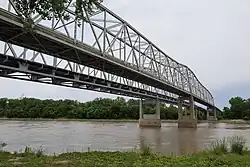
|
Liberty Bend Bridge | 1949 continuous truss span | 2001 continuous truss span | |
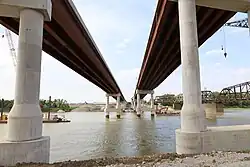
|
New Buck O'Neil Bridge | 2024 beam spans | ||
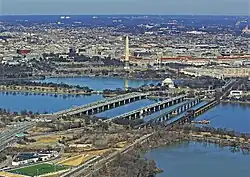
|
14th Street bridges | Five spans, see article | ||
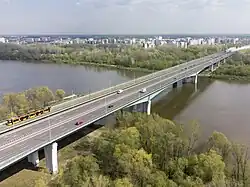
|
Maria Skłodowska-Curie Bridge | Three 2012 beam spans | ||

|
Sir Leo Hielscher Bridges | 1986 cantilever box girder span | 2010 cantilever box girder span | |

|
Iron Cove Bridge | 1955 steel truss bridge | 2011 box girder span | |
References
- ^ a b Guidance for Good Bridge Design (Google books). Luasanne, Switzerland: Fédération Internationale du Béton. 2000. p. 15. ISBN 2-88394-049-5. Retrieved October 3, 2009.
In order to ensure better management and maintenance of such structures, but also in order to limit the risk that the bridge must be closed in cases of serious highway accidents, most authorities impose a solution of twin bridges which are totally independent of each other. It is clear that in most common cases this is a reasonable and judicious solution.